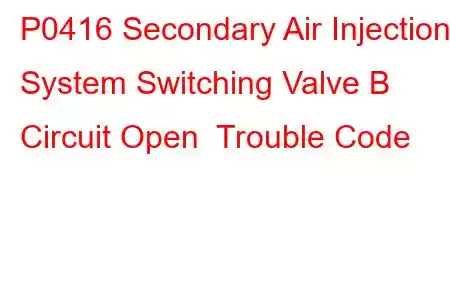P0416 Secondary Air Injection System Open
OBD-II Trouble Code Technical Description
Secondary Air Injection System Switching Valve B Circuit Open
What does that mean?
This diagnostic trouble code (DTC) is a generic powertrain code, which means that it applies to OBD-II equipped vehicles (Dodge, Ram, Ford, GMC, Chevrolet, VW, Toyota, etc.). Although generic, the specific repair steps may vary depending on make/model.
When I have been faced with diagnosing a code P0416, it has meant that the powertrain control module (PCM) has detected a malfunction in a secondary air injection (SAI) system switching valve circuit. This particular switching valve has been given the designation B. Typically B refers to a particular switching valve in a system that uses multiple switching valves.
In diagnostic terms, the word open could be substituted for disconnected, broken, or cut. Consult a reliable vehicle information source to determine the configuration of the SAI switching valve circuits for the vehicle in question and the exact location of switching valve B. As a method of reducing harmful exhaust emissions, the SAI system pumps ambient air into the engine exhaust system. Most automotive SAI systems use a belt driven pump to draw-in ambient air, compress it slightly, and inject the pressurized air into the engine exhaust manifolds.
One-way valves, switching valves, anti-backfire valves, and bypass valves, controlled by the PCM, are utilized to regulate and distribute air pressure as well as to protect the SAI pump. The PCM receives voltage input signals from strategically placed pressure sensors to monitor fluctuations in SAI system pressure. When the required parameters are reached, the PCM electronically opens the necessary valves and allows secondary air to be pumped into the exhaust system.
Some vehicles are equipped with SAI systems designed with an electronic pump. In this type of system, the PCM monitors pressure sensors and activates the pump when required.
If the PCM detects a voltage input signal from the SAI switching valve (designated as B) that is too low or non-existent, a code P0416 will be stored and a malfunction indicator lamp may be illuminated.
Other secondary air injection system trouble codes include P0410, P0411, P0412, P0413, P0414, P0415, P0417, P0418, P0419, P041F, P044F, P0491, and P0492.
Code Severity & Symptoms
The SAI system is related only to exhaust emission reduction and is not vital to engine operation. A stored code P0416 should not be considered severe.
Symptoms of this code may include:
There are likely to be no symptoms associated with this code A hissing or chugging noise from the SAI pipes or pump is possible Loud whining from SAI pumpCauses
Potential causes for this code to set are:
Burnt or broken wiring and/or connectors in the SAI system Frozen SAI pump (in geographic areas of extreme cold climate) Defective SAI pump Faulty SAI pump relay Bad SAI pressure sensorDiagnostic and Repair Procedures
A diagnostic scanner, a digital volt/ohmmeter (DVOM), and a reliable vehicle information source will be required to diagnose a code P0416.
I would begin my diagnosis by inspecting system wiring and connectors and the serpentine belt which drives the pump (if applicable). Repair or replace open circuits as required and retest the system. If the pump is belt driven, and the belt is missing or otherwise defective, replace it before proceeding. Make sure that the pump will spin freely by hand before replacing the belt. Pump failure is relatively common in high mileage vehicles. If the SAI pump is driven by an electric motor, I like to check system fuses and relays at this time too.
If a visual inspection leads to no obvious malfunctions, connect the scanner to the vehicle diagnostic port and retrieve all stored codes and freeze frame
Read: 41


